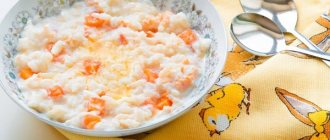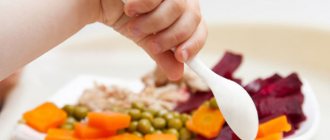At six months, it’s time for your baby to be given complementary foods. Mom should find out what “adult” foods and how exactly to feed the baby.
The only acceptable and most healthy food for a little person who has just been born is mother's milk. As a last resort - an adapted mixture. But the time comes when the baby needs “adult” food - new products in his diet. Despite the fact that each child is individual, pediatricians and pediatric nutritionists still recommend, taking into account the characteristics of the infants’ body, to start feeding the baby only when he is 6 months old.
How to introduce complementary foods to a baby at 6 months of age while breastfeeding, where to start?
By six months, the little body is already being rebuilt to eat new food. It already contains:
- a number of digestive enzymes are formed that can accept food other than milk
- a sufficient level of local immunity is strengthened; the need for other proteins, vitamins and minerals increases (the appearance of the first tooth may be an indicator of this)
- The swallowing reflex gradually changes - the baby gradually learns to swallow food from a spoon, etc.
At six months, the baby’s body is ready for complementary feeding.
So, according to modern medical recommendations, at 6 months the baby is ready to receive “adult” food, but in a form adapted for him - homogeneous.
IMPORTANT: It must be said that some mothers successfully begin feeding a 4-month-old baby. This is all normal and acceptable, taking into account the individual characteristics of the baby and the characteristics of his previous feeding
Complementary feeding begins with:
- vegetables, pureed
- cough
- juices
If possible, it is better to buy your child special baby food, which is ideally balanced and designed for use by children of different ages - 6 months, 9 months, and so on.
Vegetable puree is an ideal dish for first feeding.
- In factory-made food for babies, all requirements are met - it is perfectly crushed, prepared in such a way that all the beneficial substances of the products are preserved as much as possible, and some are even specially added, it is tested and microbiologically safe
- You need to start adding variety to your baby’s diet with one-ingredient baby food; later you can add two-ingredient purees and cereals
- A breastfed baby receives all the necessary nutrients - proteins, vitamins, microelements from mother's milk
- It also plays the role of a psychological factor - by latching on to the mother’s breast, the child feels calm and protected. Mother's milk also helps to form the child's body's defenses.
The introduction of complementary foods is not a reason to stop breastfeeding.
IMPORTANT: When starting complementary feeding, you do not need to give up breastfeeding, because the baby receives approximately 70% of its energy and most of its nutrients from mother’s milk. Complementary feeding is not a replacement, but an addition to breast milk.
- If the baby initially refuses any complementary foods, no matter what they are, and continues to eat only mother’s milk, there is no need to refuse him, however, you need to be persistent
- For example, today the child categorically refused to accept new food, do not force him, try feeding him again for a couple of days
- New foods should be introduced to your child in the middle of the day, but not before bedtime.
- After a portion of a new treat, if the child is worried, you can supplement him with mother’s milk or formula
- You should start complementary feeding with small doses - a third or half a teaspoon per day. The dose of complementary foods is gradually increased until it reaches the daily norm for a particular product - 150 - 180g
WHO complementary feeding scheme.
WHO recommends that vegetables that grow in the latitudes where he lives be the first to be introduced into a baby’s “adult” diet. The reaction to exotic foods can be quite violent, so it’s better to start feeding him:
- zucchini
- cauliflower
- carrots
- pumpkin
- potatoes
There should be no rush when introducing complementary foods.
Mom might do something like this:
- give your baby half a teaspoon of homogenized zucchini and wait for the reaction to it
- in a week or two, gradually increase the portion and bring its size to normal (according to age)
- give the child a taste of cauliflower brought to a puree state, wait for the reaction again when the child reacts normally to puree from both monoproducts, you can combine vegetables in one dish
IMPORTANT: If the child’s body reacted to a new product in some way incorrectly - he developed loose stools, a rash, etc., complementary feeding from this product should be postponed for at least two weeks. Then you can try giving it again. If you have a repeated negative reaction to the product, you should contact your pediatrician.
- After homogenized vegetables, it’s time for porridge. Although doctors allow them to be given first if the child is not gaining weight well
- If the baby initially ate only mother's milk and is not familiar with formulas, cow's or goat's, it is better to give him dairy-free cereals at first.
- Later, at 8–9 months, you can try adding milk to cereal dishes. You can also feed your baby porridge for dinner, then he will be well-fed and sleep soundly
- Then juices (vegetables, apple) and fruit purees (apple) are introduced.
- They are given a few drops at a time, since they can still irritate the baby’s gastric mucosa. It is also important to ensure that the child does not have allergies.
Kefir, cottage cheese, and meat are introduced to the child later.
If a breastfed baby does not want to drink additional juice, compote or tea, there is no need to insist - he will get the required amount of liquid from his mother's milk.
Applesauce
To prepare you need: apple (150 g).
How to cook:
We wash the apple and remove the peel and core, cut it into small pieces. Boil until soft. Place the apple in a blender, add 1 tablespoon of water, and puree until smooth. The dish is ready.
Keep in the refrigerator for no more than two days. Another simple recipe for the children's menu.
Read - Apple in baby's complementary feeding.
How to introduce complementary foods to a 6-month-old baby with artificial feeding, where to start?
- A bottle-fed baby can receive complementary foods earlier than one whose mother is breastfeeding.
- “Adult” foods should only be given when the child is completely healthy. The best time for vegetable dishes is lunch, for porridge - lunch and dinner
- Vegetables and cereals are introduced into the diet of artificial babies in the same way as into the diet of breastfed children
Complementary feeding for an artificial baby is introduced in the same way as for a baby, only a little earlier.
- We also offer the child first dairy-free porridge, then porridge with milk diluted in half with water, and only lastly do we add whole milk to it
- From six to seven months, the baby is given an egg yolk, crushed and added either to purees or to milk. You need to start with a quarter of the yolk
- During this same period of a child’s life, meat can be gradually introduced into his diet. If you do not buy ready-made food for your baby in a special store, then when preparing the product at home, you must grind the meat in a blender until it reaches a homogeneous porridge-like consistency so that there are no lumps and the child cannot choke.
- The best meat for an artificial baby would be veal, beef, rabbit or chicken. Beef and veal contain a lot of iron, and this is important for the baby’s body.
IMPORTANT: You should not give a small child meat broth, it is difficult for his unformed digestive system
Meat for complementary feeding should be chopped.
- Starting from the age of six months, children's dairy kitchens offer children lactic acid products, which a pediatrician will help you choose.
- They are important for the child's body as suppliers of beneficial bacteria for the intestines, as suppliers of protein and calcium. However, you shouldn’t get too carried away with such products - it’s enough to give them once a day so that the baby’s kidneys have time to cope with the additional amount of protein
- From the age of 8 months, the baby can be introduced to the diet of fish containing vitamin D, which is so necessary for the child’s body.
- In general, the beginning and type of complementary feeding for a baby is determined individually, depending on his development. As already mentioned, if the child is not gaining weight, then complementary feeding should begin with cereals
Carrot mousse with zucchini
You will need: carrots (120 gr.), zucchini (1 pc.), olive oil (1 tbsp.), honey (1/2 tsp.)
How to cook:
We wash and peel the vegetables, remove the seeds from the zucchini. Cut the peeled ingredients into small pieces.
Transfer the prepared products into the pressure cooker, add a little oil and leave to simmer, stirring regularly, for about 2 minutes. Then add 5 tablespoons of water, cover with a lid and leave to simmer over low heat for about 15 minutes until the ingredients soften.
Cool the vegetables, add honey and grind with an electric mixer to a mousse.
This recipe can be included in the children's menu in the “Desserts” section, as in another carrot dish for kids - “Apple and Carrot Casserole”.
Feeding porridge at 6 months
Porridges for complementary feeding today are varied.
The rules for introducing porridge into the diet of a baby up to one year are as follows:
- They are given to an infant for the first time at 6-7 months, to an artificial child - at 4.5 - 5 months.
- Cereal porridges are necessary as a source of carbohydrates, vitamins, and vegetable proteins
- Porridge without milk is introduced first
- It is better to start with buckwheat, rice, corn and oatmeal. If a child has constipation, rice should be given with caution.
- When it becomes clear that the child’s body has become accustomed to the porridge and digests it normally, it is worth trying to add vegetables or fruits mashed to a soft puree.
- The first portion of porridge should be one spoon. Every day the dose can be increased from two spoons or more
- If the child is on artificial nutrition, then after introducing porridge into complementary foods, the volume of the mixture from the bottle should be reduced so that the total volume of products is approximately 180 - 200 ml
WHO recommends starting complementary feeding with dairy-free porridge.
Pumpkin puree
For cooking you will need: pumpkin (200 gr.), milk mixture (125 ml.).
How to cook:
We carefully wash the pumpkin and remove the seeds, cut it into small cubes. Transfer it to a pressure cooker and cook until it softens. Then pour into a blender, add the mixture and grind to puree.
Store in the refrigerator for no longer than two days.
We can replace pumpkin with potatoes or avocado.
Pasta with zucchini and corn
For the dish you will need: butter (20 gr.), tomato (1 pc.), zucchini (1 pc.), small pasta (60 gr.), corn (2 tbsp.). 500 ml dish.
How to cook:
Wash the zucchini and tomato, peel and cut into small pieces or grate. Melt the butter in a deep frying pan and add vegetables there. Stir until they soften.
Boil the pasta in a pressure cooker, drain the water and transfer it to a small plate, adding fried vegetables and corn to it.
Keep in the refrigerator for no longer than two days. This is a dinner for a 6 month old baby.











